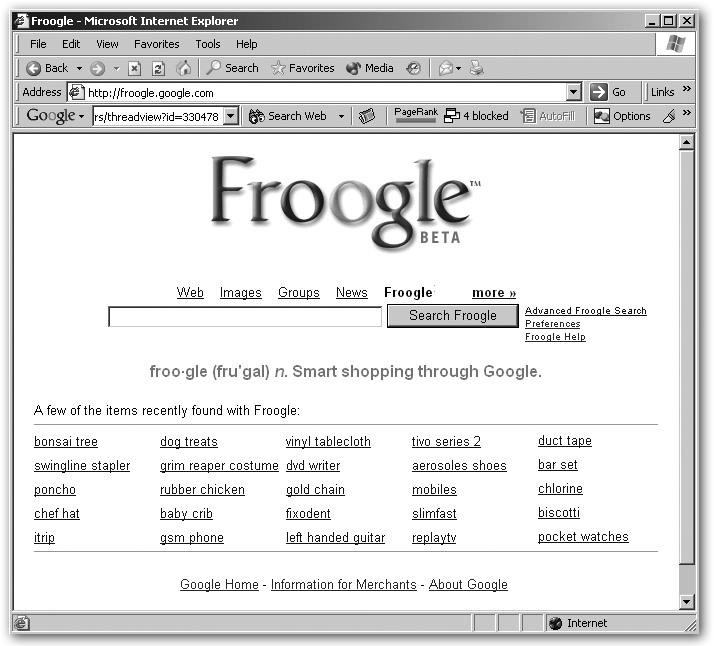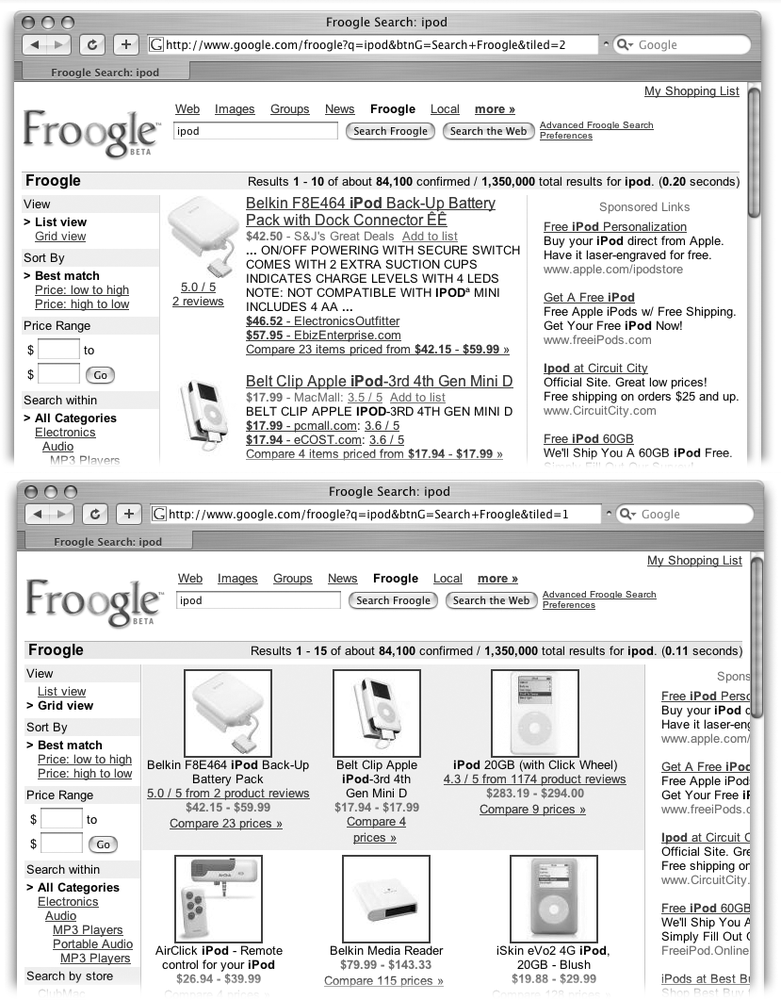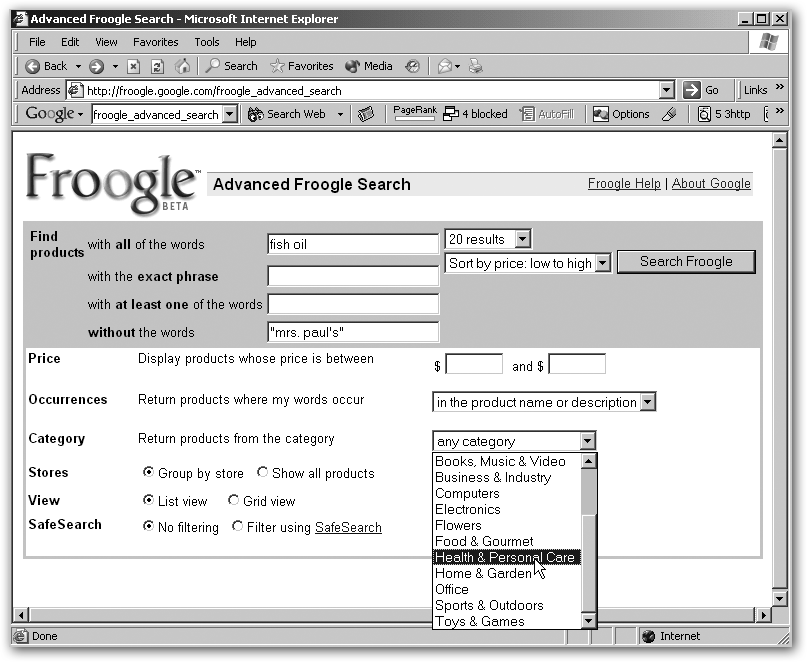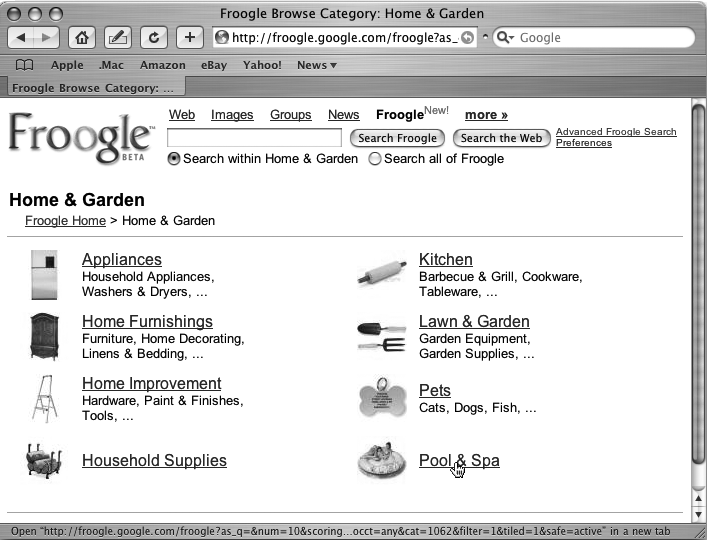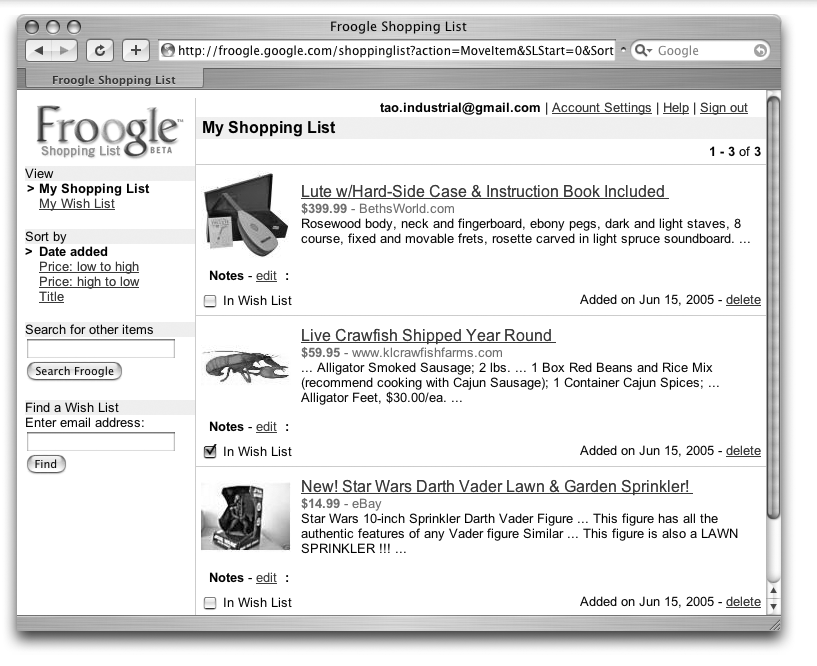Chapter 5. Shopping with Google
Tracking news and finding answers to your burning science questions are nice benefits of the Web. But the real fun online is, as any human with a credit card can tell you, shopping. The Web has it all: belt sanders, pregnancy tests, The Simpsons Monopoly sets, Bulgari jewelry, cotton candy machines, ATV tires, wild fennel pâté. There’s no limit to what you can buy.
But finding the goods is another matter. If dozens or hundreds of sites sell your desired item, you need a team of assistants and a complex spreadsheet just to figure out who has, say, the cheapest rubber chickens or the best deal on hole punchers.
Shave a few months off every product search, then, by clicking over to Froogle (http://froogle.google.com). Froogle—the word is a pleasing mix of Google and frugal—is a service to help you find things sold online and compare them by price. It’s an indispensable shopping tool.
Note
Froogle isn’t a store; it just brings you links, pictures, and product information from e-commerce sites across the U.S. If you want to buy something, you have to jump to the merchant’s site. (Google doesn’t get a cut of sales that come through Froogle searches, nor does it charge e-tailers to be part of Froogle listings.)
When to Use Froogle
Froogle is particularly good at finding specific products and at comparing prices. It’s not, however, great at helping you decide what to buy. If you’re in the market for a portable generator, for example, Froogle shows you about 20,000 of them, and it doesn’t include reviews or other information to help you narrow the field. So while it can give you a sense of what’s on the Web portable-generator-wise—and it can lead you to merchants you may never have heard of otherwise—it can’t help you pick the best model. Do your product research at sites like Consumer-Reports.org, BizRate.org, Epinions.com, and Consumer.gov, and then head over to Froogle to search for a specific manufacturer or model.
Furthermore, while Froogle has information for thousands of products and e-tailers, it’s not comprehensive. You may have heard that a hot woven golf bag is sold at eWicker.com, but you can’t find the item or the store through Froogle. What gives? Froogle gets its information from two sources: Google’s Web crawl (Section 3.2) and data that merchants send in directly. Merchants have to sign up to send in data (www.google.com/froogle/merchants/), and Google doesn’t quite keep track of every page on the Web. Moreover, even when Google does track a site, the site can store information like product details in a way that Google can’t record (Chapter 8 tells you more about why Google ignores all or part of some sites).
Despite the gaps, Froogle is still a terrific way to start a shopping trip on the Web. It finds and organizes information in ways that can save you time, hassle, and money.
Finding Stuff with Froogle
Like all of Google’s special searches, Froogle lets you run a keyword search or browse by category. Sort of.
At one time, the main page of Froogle had categories like Apparel & Accessories, Electronics, Health & Personal Care, and Sports & Outdoors. You could click a category to get subcategories until you hit the kind of product you wanted to shop for. But Froogle, like Google News, is what Google considers a beta service, which means it’s still experimental, and the company may add or remove features without notice. In this case, Google pulled the categories from the front page of Froogle, instead showing you examples of recent Froogle searches (Figure 5-1).
The weird thing is that Google still assigns products to different categories. You can use a workaround to browse by category, and Froogle has a kind of browsing-and-searching hybrid mode, too, as explained in Section 5.2.3.
Searching
When you know a specific item you want—say you’ve got a brand name, product name, or model number—a keyword search is the easiest way to perform your comparison-shopping search. Type your terms into the search box on Froogle’s main page, press Enter or Search Froogle, and let ‘er rip.
Figure 5-2 shows you what a results page looks like. If you click an individual result, Google takes you directly to the page selling that item.
Tip
If you’re searching for something with a well-known product name, including a brand name can sometimes narrow down your results too far. For example, a search for Apple iPod might net you fewer results than a search for iPod—and might exclude some good deals in the process. For best results, try your search both ways.
As Figure 5-2 shows, whether you choose “List view” or “Grid view,” a Froogle results page has a few parts. At the top is a search box where you can refine your search terms or run the same search—on the whole Web, in Images, Groups, and so on. Below that is a green summary bar that tells you how many results Froogle found for your search terms. (It usually says something like, “Results 1 - 20 of about 293 confirmed / 9,810 total results for deep fryer.” The confirmed results are from the data feeds that merchants send Google on a daily, weekly, or monthly basis. The rest of the results are from Google’s Web search and may be less accurate.)
Under the summary bar, the bulk of the page is taken up by your listings. On the right are sponsored links (that is, ads) for the product you’re searching for (those ads could be helpful, so don’t overlook them), and on the left is a navigation bar.
The navigation bar is a little confusing at first, but it’s easy to understand when you break it down into its five parts:
View. Here’s where you choose “List view” or “Grid view,” as explained in Figure 5-2.
Figure 5-2. Froogle lets you view your listings two different ways: as a list, or in a grid. The links in the upper-left corner, under View, let you choose. Top: The List view gives you snippets of information about the products, and it loads more quickly if you have a dial-up connection, because it has fewer pictures per page. Bottom: The Grid view lets you see more items at once, while still providing prices and links to the stores.Sort By. Google gives you three choices for the order in which it displays your results. “Best match” is Froogle’s assessment of a product’s relevance, calculated much the way Google decides the order to display regular Web page results. (Froogle shows you results sorted by best match, unless you re-sort things.) “Price: low to high” shows you lowest price first; “Price: high to low” is, obviously, the opposite. Toggle between the two price sorts to learn the range of prices for an item.
Price Range. This option lets you type in the low and high prices you want to see. It’s a great way to filter out stuff that matches your search terms but isn’t what you want. For example, if you search for iPod, Froogle includes accessories like cases and cables, plus books on the iPod. Set your low price to around $199 (the bottom street price for iPods) and your high price to whatever you’re willing to pay, and you cut your results by more than half without doing any tedious sifting.
Tip
Find just what you’re looking for but have to wait until next month’s paycheck to buy it? Sign up for a Froogle Shopping List (Section 5.2.3) and click the “Add to list” link under the desired item to store a little reminder to buy it after that paycheck lands.
Search within. This feature is part of the search/browse hybrid system on Froogle. And, frankly, it’s not very intuitive to use. Here’s the deal: When you run a Froogle keyword search, this section shows you the categories and subcategories that contain your results. So if you search for iPod, Froogle tells you that you can find iPods in the following categories: Electronics, Audio, Portable Audio, MP3 Players, and, um, MP3 Players. (How those last two categories are different is a total mystery.) If you click any of the category links, Froogle shows you the results in that category only.
The feature isn’t very useful for the iPod search, since an iPod really does fit in all those categories. Limiting your search to, say, Portable Audio would simply cut down on your legitimate results.
But say you’re trying to find a snazzy new pair of glasses. Froogle shows you beer steins, Champagne flutes, and a mess of other glassware, along with spectacles. To home in on the eyewear, click the link for Health & Personal Care (or Vision & Hearing, a subcategory of Health & Personal Care).
Search by store. Sometimes you’re on the hunt for an item that comes in multiple varieties—like fruit baskets—and Froogle brings back scads of results from tons of stores. Say, you sort of like the pineapple-and-macadamia-nut sampler that came back in your search results, but you want to see other items the company may also sell in case there’s another assortment you like better. To isolate the merchandise from that one store, click its name under the “Search by Store” list. Froogle keeps your same search terms but lists only items from that particular store.
Unfortunately, Froogle doesn’t let you search for synonyms using the ~ character (Section 2.6.12). So, for example, if you think your item might turn up as shirt, blouse, or top, you’ve got to run searches for all three—or use the OR operator to search for them simultaneously: shirt OR blouse OR top.
Tip
A general search term like shirt is a great opportunity to use the category links in the results, because they can help you focus on men’s or women’s, t-shirts or blouses, and so on.
In fact, any time you search for something broad—be it necktie, digital camera, or steak—Froogle can give you too many results to handle. In addition to OR, you can refine your query by using the minus sign (–), the plus sign (+), and quote marks. Quotes are, of course, useful for products with more than one word (”denim jacket" or "my pretty pony“). The minus sign is particularly handy, as it lets you tell Froogle to ignore certain things, like this: steak -sauce.
Note
Froogle, unlike other Google services, does include stop words like “the” in your searches (Section 1.2.2).
Finally, you can use a few syntax elements (Section 2.6) to separate the wheat from the chaff. Froogle lets you limit your search to a particular e-commerce site, which is a good way to search just for items from your favorite merchant. To use the store operator, leave off the .com (or whatever) after the domain name, like so: shirt store:gap.
Note
You do have to know the domain name for a store, because Froogle doesn’t recognize store names. For example store:the gap gets you nowhere, because the gap.com isn’t the right domain.
If you search for store:gap without specifying an item, Froogle shows you everything it finds from the Gap’s Web site, in no particular order. But you can also sort by price or specify a price range—two tricks you might not be able to do on a store’s actual site.
Tip
You can also filter products by category—at least in a limited way. Here’s the trick: If you’re in List view, each individual result includes a link to its category. Click that link to see all the results from that category. (You can switch to Grid view, if you like, once you’ve homed in on a category.)
The problem with this system is that you can’t see a comprehensive list of categories, and if the overall results are extensive, you may not even be able to find the type of thing you’re looking for without sifting through a lot of results.
Froogle also lets you use the intitle and intext operators. Intitle searches for your terms in the product name only, while intext searches in the description only. Use them like this:
intitle:robomower
or:
robomower intext:"replacement blades"
or mix them, like this:
intitle:robomower intext:blades
You can also use allintitle or allintext to have Froogle search for several words at once (allintext:replacement blades). But you can’t mix these two elements. You can, however, toss the store operator into the mix, like this: allintitle:robotic mower store:sears, which prompts Froogle to show you all the robotic mowers Sears.com sells.
Advanced Froogle Search
If syntax makes you woozy, try the Advanced Froogle Search (Figure 5-3).
Like the advanced search forms in other parts of Google, the Froogle form lets you create a complex query without using syntax. (See Section 2.2 for a review of the ways an advanced search form can help you hone your search.)
In addition, the Advanced Froogle Search lets you predetermine the factors you’ll be able to adjust on a results page, like the price range and how you want your listings sorted. (Whether you adjust the settings here or in your results, you get the same listings.) The one element that may be easier to set from Advanced Froogle Search is the category, which you can choose from a nice, familiar menu rather than from a confusing array of links.
Note
Advanced Froogle Search also lets you turn on or off SafeSearch filtering (Section 2.1.2) for an individual search. After one search, however, all searches on Google revert to the SafeSearch setting on your general Google Preferences page (Section 2.1.2).
Shopping Lists
If there’s anything that’s survived the test of time as an incredibly great idea, it’s the shopping list; British scientists recently found ancient Roman shopping lists scratched on wooden tablets 2,000 years ago. (Clothes were just as expensive back then and they didn’t even have Old Navy.)
Maintaining a shopping list in Froogle is infinitely easier and does not involve pointy sticks. All you need is the desire to buy things and some sort of Google account, like a Gmail address and password (Section 11.1). And, unlike a shopping cart, where the online merchant expects you to check out and pay for the things you’ve picked up along your visit, a Froogle shopping list is just a reminder of the things you want to buy.
To start a Froogle Shopping List, click the My Shopping List link in the top corner of the Froogle home page. If you don’t already have a Google account, the next page invites you to start one, and walks you through the steps. Your email address serves as your Froogle user name.
If you already have a Gmail or other Google account, just type in your account name and password, and click the Sign In button. After you agree to the obligatory Terms of Service/Privacy Policy screen that comes next, you’ve got yourself a Froogle Shopping List.
Now, when you’re out on a capitalist tear through Froogle’s search results, click the “Add to list” link under any item you’ve got your eye on. The links and descriptions for your collected items are neatly stored and displayed on your Froogle Shopping List for future reference, as shown in Figure 5-4.
If you want to write yourself a note on a particular item (“Get this for Sally’s birthday but ask her husband if she likes taupe or teal better”), click the “edit” link under the product image to add some notes to your selected item. You can arrange the items on your list by their names, the date you added them, or their prices.
This information gets stored on Google’s servers—not your own hard drive—so you can get to your Shopping List from any computer with a working Web browser. (Imagine: You can now shop at home and buy at work!) When you’re ready to buy any or all the items on your list, sign in to your Froogle page and use the item links to finally seal the deal with the online merchant selling the product. If you change your mind about an item and don’t want to buy it after all, just click the “delete” link next to the product to scratch it from your list.
Froogle Wish Lists
The Wish List feature over at Amazon.com has saved thousands of marriages from husbands who think an electric can opener makes a darn fine birthday gift. Froogle, therefore, includes the helpful Wish List feature for its shoppers as well.
With a Wish List, you collect—on your Froogle Shopping List—the items you would like to have and then turn on the In Wish List checkbox to make them appear on a version of your Froogle Shopping List that can be seen by the public—or at least the members of the public who thoughtfully look up your Wish List.
Tip
To get the direct link for your Froogle Wish List—so you can alert the gift givers in your life—click the My Wish List link under View on the left side of your Froogle Shopping List page. The link appears at the top of the Wish List page, ready for cutting and pasting into an email message.
To find somebody else’s Froogle Wish List, just type in the person’s email address on the Froogle home page and then click the Find button. The Wish List appears, with only the items marked for Wish Listing shown. Any items the person has not specifically marked stay hidden, so no one will know that your niece has, say, a secret desire to buy a lute.

